This document is a project report submitted to a professor that examines generation gaps in the workplace at Allied Bank. It includes an acknowledgements section, executive summary, table of contents, and 10 chapters. The introduction provides background on Allied Bank and defines key terms like generations, generation gap, and organizational setting. The report aims to identify if a generation gap exists, compare characteristics of different age groups, and identify areas of conflict among generations. It will analyze employee survey responses from Allied Bank to understand motivational factors and characteristics of different generations. The executive summary previews the findings that generation gaps do exist and differences were found in characteristics and motivational factors among generations.
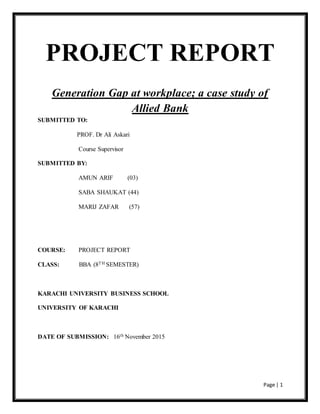

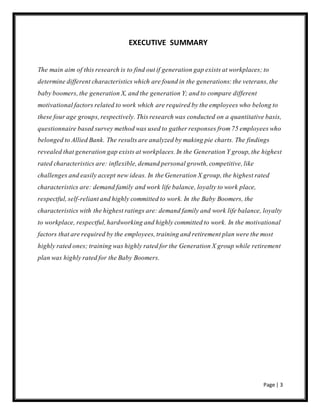





























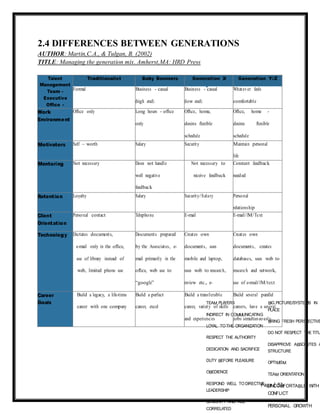
















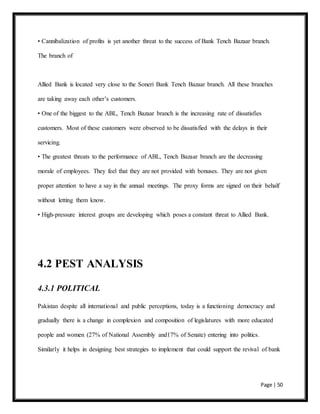



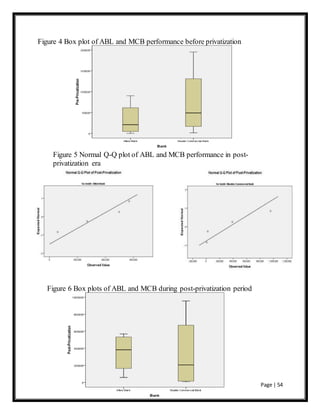

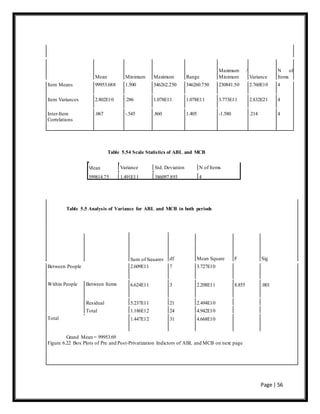






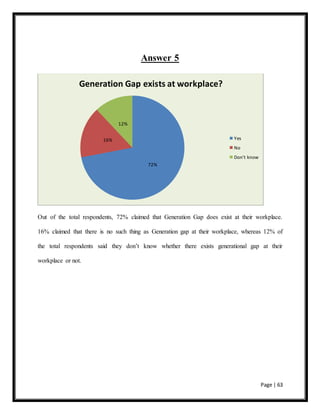











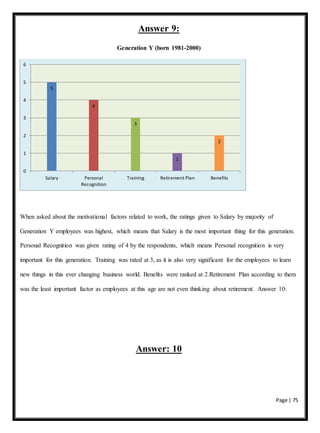



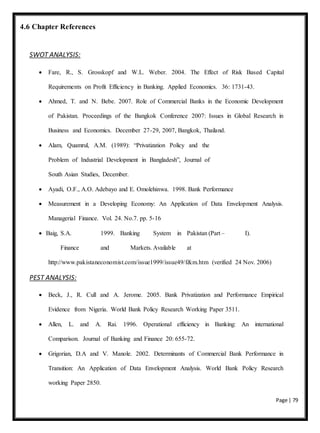
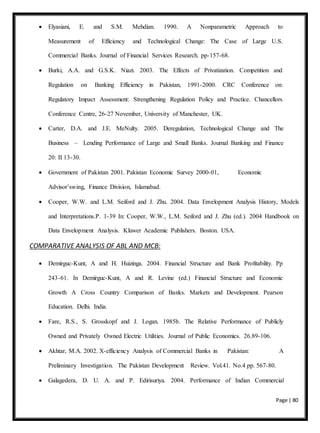




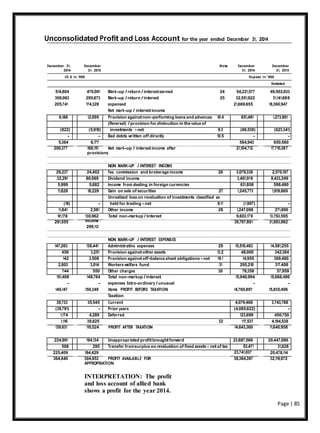


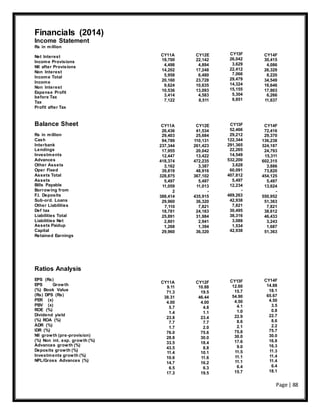
































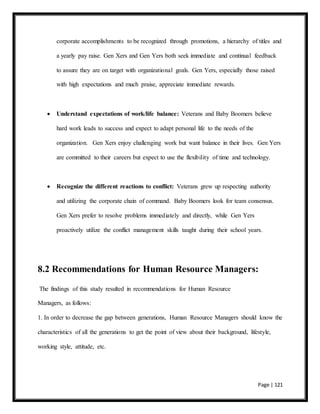






![Page | 128
Rath, D. (1999). Bridging the generation gap. InfoWorld, 21, 84.
Smola, K. W. & Sutton, C. (2002). Generational differences: Revisiting generational
work values for the new millennium. Journal of Organizational Behavior, 23, 363–382.
Tang, T.L. & Tzeng, J. Y. (1992). Demographic correlates of the protestant work ethic.
Journal of Psychology, 126, 163–170.
The National Oceanographic and Atmospheric Association Office of Diversity (2006).
Tips to improve the interaction among the generations: Traditionalists, boomers, X’ers
and nexters. Retrieved April 15, 2008, from http://honolulu.
hawaii.edu/intranet/committees/FacDevCom/ guidebk/teachtip/intergencomm.htm
Valueoptions.com. Generation Y [Born 1980–1994]. Retrieved April 15, 2008, from
http://www. valueoptions.com/spotlight_YIW/gen_y.htm
Valueoptions.com. Generation X [Born 1965–1980]. Retrieved April 15 2008, from
http://www. valueoptions.com/spotlight_YIW/gen_x.htm
Valueoptions.com. The baby boomer generation [Born 1946–1964]. Retrieved April 15,
2008, from http://www.valueoptions.com/spotlight_YIW/baby_ boomers.htm
Yang. S. M., & Guy, M. E. (2006). GenXers versus boomers: Work motivators and
management implications. Public Performance & Management Review, 29, 267–284.
Zemke, R., Raines, C., & Filipczak, B. (1999). Generations at work: Managing the clash
of veterans, boomers, Xers, and nexters in your workplace. New York: AMACOM.
Ahmed T. and W. Ahmed 2007. Analysis of Technical Efficiency in Banking Sector
With Respect to its Inputs.
Hoque, M and C. Fernandes (Ed.) Proceeding of the Fifth International Business
Research Conference 2007: Strands of Development. April 26-27. 2007, Dubai,](https://image.slidesharecdn.com/91d4976c-9625-4f70-8758-4c1957cbe81c-160414183211/85/final-thesis-128-320.jpg)





![Page | 134
BIBLIOGRAPHY
Ahmed T. and W. Ahmed 2007. Analysis of Technical Efficiency in Banking Sector
With Respect to its Inputs
Ahmed, T. and N. Bebe. 2007. Role of Commercial Banks in the Economic Development
of Pakistan. Proceedings of the Bangkok Conference 2007: Issues in Global Research in
Business and Economics. December, 2007, Bangkok, Thailand.
Akhtar, M.A. 2002. X-efficiency Analysis of Commercial Banks inPakistan: A
Preliminary Investigation. The Pakistan Development Review. Vol.41. No.4.
Al-Faraj, T.N., A.S. Alidi and K.A Bu-Bshait. 1993. Evaluation of Bank Branches by
Means of Data Envelopment Analysis. International Journal of Operations & Production
Management, Vol.13 No.9.
Alam, Quamrul, A.M. (1989): “Privatization Policy and the Problem of Industrial
Development in Bangladesh”, Journal of South Asian Studies, December.
Allen, L. and A. Rai. 1996. Operational efficiency in Banking: An international
Comparison. Journal of Banking and Finance 20.
Ayadi, O.F., A.O. Adebayo and E. Omolehinwa. 1998. Bank PerformanceAdams III, J.
T. (1999, November.). What Gen Xers Want From Work. HR Magazine, 44(11).
Adams, S. J. (2000, January.). Generation X. Professional Safety, 4(1).
Alverson, M. (1999, May/June). The New Generation Gap. Woman in Business.
Anon, (2014). [online] Available at: http://www.dallasiia.org/PDF/090414_Lunch2.pdf
Au.answers.yahoo.com, (2010). Question: "What its like to be a teenager in todays
society"? - Yahoo Answers. [online] Available at:
https://au.answers.yahoo.com/question/index?qid=20101122071117AAyoCC1](https://image.slidesharecdn.com/91d4976c-9625-4f70-8758-4c1957cbe81c-160414183211/85/final-thesis-134-320.jpg)

![Page | 136
Coolidge, S. D. (1999, August. 9). Generations Apart. Christian Science Monitor.
Corbo, S. A. (1997, April. 5). The X-er Files. H&HN: Hospitals & Health Networks.
Cox, J. (2000, July. 24). Management strategies: The A-B-C’s of managing Generation X
[On-line] <http://www.media3pub.com/southtrust/articles/genx.html>
Carter, D.A. and J.E. MeNulty. 2005. Deregulation, Technological Change and The
Business – Lending Performance of Large and Small Banks. Journal Banking and
Finance.
Charnes, A., W.W. Cooper and E. Rhodes. 1978. “Measuring the Efficiency of Decision
Making Units”, European Journal of Operational Research.
Clarke, G.R.G., J.M. Crivelli and R. Cull. 2005. The Direct and Indirect Impact Of Bank
Privatization and Foreign Entry on Access to Credit in Argentina’s Provinces. Journal
Banking and Finance.
Cooper, W.W. and L.M. Seiford and J. Zhu. 2004. Data Envelopment Analysis History,
Models and Interpretations In: Cooper, W.W., L.M. Seiford and J. Zhu (ed.). 2004
Handbook on Data Envelopment Analysis. Kluwer Academic Publishers. Boston. USA.
DI Manage, (2011). Generation Y: in South Africa Today. [online] Available at:
http://dimanage.wordpress.com/2011/01/06/generation-y-in-south-africa-today/
Demirguc-Kunt, A and H. Huizinga. 2004. Financial Structure and Bank Profitability. In
Demirguc-Kunt, A and R. Levine (ed.) Financial Structure and Economic Growth A
Cross Country Comparison of Banks. Markets and Development. Pearson Education.
Delhi. India.
English Language, Dictionary of American Heritage (2009).4th Edition.Houghton Mifflin
Company. Available at: http://www.eref-trade.hmco.com](https://image.slidesharecdn.com/91d4976c-9625-4f70-8758-4c1957cbe81c-160414183211/85/final-thesis-136-320.jpg)
![Page | 137
Ey.com, (2014). Advisory, Assurance, Tax, Transaction Services. [online]
Elyasiani, E. and S.M. Mehdian. 1990. A Nonparametric Approach to Measurement of
Efficiency and Technological Change: The Case of Large U.S. Commercial Banks.
Journal of Financial Services Research.
Filipczak, B. (1994, April.). It’s just a job generation X at work. Training.
Finance.youngmoney.com, (2014). » Boomers to Millennials: Generational Attitudes.
[online] Available at: http://finance.youngmoney.com/careers/boomers-to-millennials-
generational-attitudes/
Fare, R.S., S. Grosskopf and J. Logan. 1985b. The Relative Performance of Publicly
Owned and Privately Owned Electric Utilities. Journal of Public Economics.
Fare, R., S. Grosskopf and W.L. Weber. 2004. The Effect of Risk Based Capital
Requirements on Profit Efficiency in Banking. Applied Economics.
Fatima, M. 2006. How Autonomous Can a Central Bank be? May 13. Special
Supplement Asia Finance Conferences, Daily Dawn, Lahore.
Fisher, A. (1996, September. 30). Wanted: Aging Baby-Boomers. Fortune.
Flynn, G. (1996, November.). Xers VS Boomers: teamwork or trouble? Personnel
Journal.
Freund E. J., & Perles M. B. (1974). Business Statistics. Prentice-Hall, Inc., Englewood
Cliffs, N. J.
Generation X (2000, July. 24). [On-line] <http://www.bssb.com/BibleInsites/genx.htm>
Gen X Volunteers. (2000, July. 24). [On-line]
<http://www.merrillassoc.com/Topics/genx.html>](https://image.slidesharecdn.com/91d4976c-9625-4f70-8758-4c1957cbe81c-160414183211/85/final-thesis-137-320.jpg)
![Page | 138
Galagedera, D. U. A. and P. Edirisuriya. 2004. Performance of Indian Commercial Banks
(1995-2002): An Application of Data Envelopment Analysis and Malmquist
Goldsmith, R.W., 1969 Financial Structure and Development. New Haven, CT: Yale
University, Press.
Government of Pakistan 2001. Pakistan Economic Survey 2000-01, Economic
Advisor’swing, Finance Division, Islamabad.
Government of Pakistan 2002, Pakistan Economic Survey 2001-02, Advisor’s wing,
Finance Division, Islamabad. Government of Pakistan 2003, Pakistan Economic Survey
2002-03, Advisor’s wing, Finance Division, Islamabad Government of Pakistan 2004,
Pakistan Economic Survey 2003-04, Advisor’s wing, Finance Division, Islamabad
Government of Pakistan 2006, Pakistan Economic Survey 2005-06, Advisor’s wing,
Finance Division, Islamabad Government of Pakistan 2007, Pakistan Economic Survey
2006-07, Advisor’s wing, Finance Division, Islamabad Grabowski, R.N. Rangan and R.
Rezvanian, 1993. Organizational forms in Banking: An Empirical Investigation of Cost
Efficiency. Journal of Banking and Finance.
Grigorian, D.A and V. Manole. 2002. Determinants of Commercial Bank Performance in
Transition: An Application of Data Envelopment Analysis. World Bank Policy Research
working Paper.
GetMeMedia.com, (2014). Win a £50,000 Native Advertising Campaign with The
Debrief!. [online] Available at: http://www.getmemedia.com/ideas/win-a-50000-native-
advertising-campaign-with-the-debrief/bauer-media.html
Hedden, J. (2000, July. 24). Twenty Somethings: Managing the New Breed of Employee
[On-line] <http://www.restaurant.org/RUSA/1996/9609p22.htm>](https://image.slidesharecdn.com/91d4976c-9625-4f70-8758-4c1957cbe81c-160414183211/85/final-thesis-138-320.jpg)
![Page | 139
Hildreth, S. (2000, July. 24). X-cellent Job [On-line]
<http://users.aol.com/writersjh/xers.html>
Hornblower, M. (1997, June. 9). Great Xepectations. Time.
How do you train generation Xers? (1995, May). Training &development.
Investopedia (n.d.). Investopedia. Available at:
http://www.investopedia.com/terms/g/generation-gap.asp
Jennings, L. (2000, Mar/April). Trends in the Multigenerational Workplace. Futurist,
34(2).
Jennings, Marianne M. (1999, November.). What’s Behind the Growing Generation Gap?
USA Today Magazine.
Jonker, N., Jonker, N. and profile, V. (2012). Nate's News and Notes!: Born Around
1980? Read below to learn about the 2020 leaders.. [online] Nates-news-
clio.blogspot.com. Available at: http://nates-news-clio.blogspot.com/2012/03/born-
around-1980-read-below-to-learn.html
Jurkiewicz, Carole L. (2000, Spring). Generation X and the Public Employee. Public
Personnel Management.
Kaeter, M. (1995, January.). AGE-OLD MYTHS. Training.
Kane, S. (2014). Profile of Generation Y Legal Professionals. [online] About. Available
at: http://legalcareers.about.com/od/practicetips/a/GenerationY.htm
Knight, J. (1999, August.). The school of Hard Rocks. Training.
Kscpa.org, (2011). The Pros and Cons of E-mail Use During the Audit by Alan W.
Anderson, CPA - News - About - Kansas Society of CPAs & Educational Foundation.](https://image.slidesharecdn.com/91d4976c-9625-4f70-8758-4c1957cbe81c-160414183211/85/final-thesis-139-320.jpg)
![Page | 140
[online] Available at: http://www.kscpa.org/about/news/35-the_pros_and_cons_of_e-
mail_use_during_the_audit
Losyk, B. (1997, May). Generation X. Current.
Losyk, B. (2000, July. 24). Generation X-ceptional: How to manage & motivate the
under 30 workforce [On-line] <http://www.boblosyk.com/Article.htm>
Lucas, B. (2000, July. 24). Generation X: Coming of Age in the ‘90s [on-line]
<http://www.npd.com/genx.htm>
Macalister, K. (1994, May). The X generation. HR Magazine.
Malloy, J. (2000, July. 24). What drives generation X? Motivating Gen Xers on the job
[On-line] <http://www.isa.org/journals/intech/feature/printable/1,2563,306,00.html>
Martinez, Michelle N. (1995, February.). Generation X has good attitude. HR Magazine.
Millar, G., Millar, G., Millar, G., Millar, G. and Millar, G. (2014). October | 2013 | The
Inter-Gen Consulting Group. [online] Inter-gen.com. Available at: http://www.inter-
gen.com/wordpress/?m=201310
Multiculturaladvantage.com, (2014). Generational Diversity in the Workplace. [online]
Available at: http://www.multiculturaladvantage.com/recruit/group/mature/cont/gdiw-
3.asp
Munn, A. (2014). How Are Different Generations Working Together in Hospitals?.
[online] HealtheCareers Blog. Available at: http://news.healthecareers.com/2012/02/how-
are-different-generations-working-together-in-hospitals/
Nagle, T. (2000, July. 24). Coaching Generation X [On-line]
<http://www.coachingandmentoring.com/Articles/x’s.html>](https://image.slidesharecdn.com/91d4976c-9625-4f70-8758-4c1957cbe81c-160414183211/85/final-thesis-140-320.jpg)
![Page | 141
Nance-Nash, S. (2000, July. 24). The Gen X Employee [On-line]
<http://www.fsb.com/fortunesb/articles/0,2227,69,00.html>
Okrent, D. (2000, December. 6). TWILIGHT OF THE BOOMERS. Time.
Phillips.S. (2011). X and Y: The Impact of The Gap. Gonzaga University. Available at:
http://www.gonzaga.edu/comltheses/proquestftp/Phillips_gonzaga_0736M_10098.pdf
profile, V. (2010). E-Marke Blogs: July 2010. [online] Ciriacoemman.blogspot.com.
Available at: http://ciriacoemman.blogspot.com/2010_07_01_archive.html
PRWeb, (2014). ISMAmerica Announces The Release Of The American Financial Fitness
Plan. [online] Available at: http://www.prweb.com/releases/ismamerica/ismamerica-
reviews/prweb8943926.htm
Ratan, S. (1993, October. 4). Generational tension in the office: why busters hate
boomers. Fortune.
Raths, D. (1999, September. 11). Bridging the generation gap. Info World.
Raz, T. (2000, July. 24). Are You Talking About Me? [On-line]
http://www.myprimetime.com/work/life/content/intergenerational/index.shtml
Raz, T. (2000, July. 24). Showdown at generation gap [On-line]
<http://www.myprimetime.com/work/jobs_hiring/content/genx/index.shtml>
Rogers, J. (2000, July. 24). Generation X: Makes this generation different? [On-line]
<http://www.forerunner.com/forerunner/X0856_Generation_X.html>
Rosner, B. (1999, July.). How do you deal with generation-X workers? Workforce.
Rpsblog.raytr.com, (2014). The Gen Y Training Effect. [online] Available at:
http://rpsblog.raytr.com/index.php/the-gen-y-training-effect/](https://image.slidesharecdn.com/91d4976c-9625-4f70-8758-4c1957cbe81c-160414183211/85/final-thesis-141-320.jpg)
![Page | 142
Ruch, W. (2000, April.). How to Keep Gen X Employees From Becoming X-Employees.
Training & Development.
Salopek, Jennifer J. (2000, February.). The young and the rest of us. Training &
Development.
Schizas, Charalambos L. (1999, June.). Capitalizing on a generation gap. Management
Review.
Seglin, Jeffrey L. (2000, August.). What’s the matter with kids today? Inc.
Stauffer, D. (1997, December.). For generation Xers, what counts isn’t all work or all
play. Management Review.
Stereotype generation X at your peril. (1998, June. 25). People Management.
Stoneman, B. (1998, May). Beyond rocking the ages. American Demographics.
The generation gap. (1998, November.). NEA Today.
Theechoboom.com, (2014). Baby Boomer, Generation X, and Generation Y Comparison
| The Echo Boom. [online] Available at: http://theechoboom.com/2010/10/generational-
differences-baby-boomer-generation-x-and-generation-y-comparison/
Tulgan, B. (2000, July. 24). Managing Generation X [On-line]
<http://www.myprimetime.com/work/entrepreneur_toolkit/content/Managing_G…/index
.shtm>
U.S. Trust (2000, July. 24). Affluent Baby Boomers [On-line]
<http://www.ustrust.com/bb.htm>
Walker, Smith J. (2000, May). Is the Boomer/Gen-X WarOver? HR Focus.
Wellner, Alison S. (1999, August.). Boom or Bust. Training.
https://www.abl.com/ (information of Allied Bank)](https://image.slidesharecdn.com/91d4976c-9625-4f70-8758-4c1957cbe81c-160414183211/85/final-thesis-142-320.jpg)
![Page | 143
What generation gap? (1995, Mar/April). Society.
Wiant, Chris J. (1999, October.). Are you listening to your employees? Journal of
Environmental Health.
Woodward, Nancy H. (2000, July. 24). The coming of the X managers [On-line]
<http://www.shrm.org/hrmagazine/articles/0399genx.htm>
Workforce.com, (2014). Dispel Those Gen-X Myths. [online] Available at:
http://www.workforce.com/articles/dispel-those-gen-x-myths
Workforce.com, (2014). Xers vs. Boomers Teamwork or Trouble. [online] Available at:
http://www.workforce.com/articles/xers-vs-boomers-teamwork-or-trouble
Zemke, R., Raines, C., & Filipczak, B. (1999, November.). Generation Gaps in the
classroom. Training.
Zemke, R., Raines, C. & Filipczak, B. (2000). Generations At Work Managing the Clash
of Veterans, Boomers, Xers, and Nexters in Your Workplace. New York: American
Management Association.
Zetlin, M. (1995, April.). Is it worth keeping older salespeople? Sales & Marketing
Management.](https://image.slidesharecdn.com/91d4976c-9625-4f70-8758-4c1957cbe81c-160414183211/85/final-thesis-143-320.jpg)




